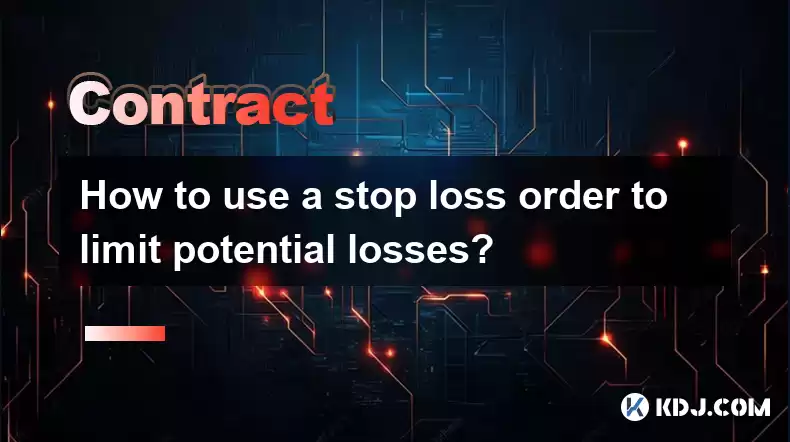-
 bitcoin
bitcoin $123963.239194 USD
1.37% -
 ethereum
ethereum $4529.082464 USD
1.07% -
 xrp
xrp $2.983640 USD
0.71% -
 tether
tether $1.000287 USD
0.02% -
 bnb
bnb $1179.874393 USD
2.99% -
 solana
solana $230.633678 USD
1.55% -
 usd-coin
usd-coin $0.999835 USD
0.03% -
 dogecoin
dogecoin $0.254240 USD
1.34% -
 tron
tron $0.341176 USD
0.15% -
 cardano
cardano $0.842285 USD
0.52% -
 hyperliquid
hyperliquid $48.537896 USD
-0.86% -
 chainlink
chainlink $21.863092 USD
-0.84% -
 ethena-usde
ethena-usde $0.999743 USD
-0.07% -
 sui
sui $3.579561 USD
-0.18% -
 stellar
stellar $0.403418 USD
2.67%
How to use a stop loss order to limit potential losses?
Stop loss orders offer risk management for volatile markets by triggering buy or sell orders based on predetermined prices when market conditions match those parameters.
Feb 21, 2025 at 05:48 am

- Understanding stop loss orders
- Setting up a stop loss order
- Managing stop loss orders
- Evaluating stop loss effectiveness
A stop loss order is a conditional order placed with an exchange or broker to sell or buy an asset at a predetermined price when specific market conditions are met. Stop loss orders are primarily used to manage risk and prevent potential losses in volatile markets.
- Trigger Price: This is the price at which the stop loss order will be executed.
- Order Type: Stop loss orders can be market orders, limit orders, or stop-limit orders.
- Use Cases: Stop loss orders are commonly used to limit losses on long or short positions, to protect profits, or to re-enter a trade at a specific price point.
- Identify Risk Tolerance: Determine the maximum amount you are willing to lose on a trade.
- Set the Trigger Price: Set the trigger price based on your risk tolerance and market conditions. Consider both the asset's volatility and the potential support or resistance levels.
- Choose Order Type: Select the order type that best aligns with your objectives. Market orders are executed immediately, while limit orders and stop-limit orders offer more control over execution price.
- Enter the Order: Input the stop loss order details, including the trigger price, order type, and order size, into the exchange or broker's platform.
- Monitor Trigger Price: Regularly check market conditions to ensure that the trigger price remains appropriate.
- Adjust Trigger Price: Revise the trigger price if market conditions change significantly or if the asset's price moves rapidly.
- Modify Order Size: Increase or decrease the order size based on the risk-reward trade-off and current market conditions.
- Cancel Order: Cancel the stop loss order if the trade setup becomes invalid or if the asset's price moves too far away from the trigger price.
- Backtesting: Test the stop loss strategy using historical market data to assess its effectiveness under various market conditions.
- Live Tracking: Monitor the stop loss order in real-time to ensure that it is executed as intended.
- Success Rate: Calculate the percentage of stop loss orders that successfully protected profits or limited losses.
- Slippage: Consider the potential for slippage between the trigger price and the actual execution price, especially in volatile markets.
- What is the difference between a stop loss order and a take profit order?A stop loss order is used to limit losses, while a take profit order is used to secure profits.
- Can stop loss orders guarantee against losses?No, stop loss orders do not guarantee against losses, as market conditions can change rapidly and execution may not occur exactly at the trigger price.
- What are the disadvantages of using stop loss orders?Stop loss orders can trigger false signals, especially in volatile markets, leading to premature exits. They can also lock in losses if the market trend reverses.
- How often should I adjust my stop loss order?The frequency of adjustment depends on market volatility and the specific asset being traded. Adjust the stop loss order whenever market conditions change significantly or when the asset's price approaches the trigger price.
Disclaimer:info@kdj.com
The information provided is not trading advice. kdj.com does not assume any responsibility for any investments made based on the information provided in this article. Cryptocurrencies are highly volatile and it is highly recommended that you invest with caution after thorough research!
If you believe that the content used on this website infringes your copyright, please contact us immediately (info@kdj.com) and we will delete it promptly.
- BlockDAG, DOGE, HYPE Sponsorship: Crypto Trends Shaping 2025
- 2025-10-01 00:25:13
- Deutsche Börse and Circle: A StableCoin Adoption Powerhouse in Europe
- 2025-10-01 00:25:13
- BlockDAG's Presale Buzz: Is It the Crypto to Watch in October 2025?
- 2025-10-01 00:30:13
- Bitcoin, Crypto, and IQ: When Genius Meets Digital Gold?
- 2025-10-01 00:30:13
- Stablecoins, American Innovation, and Wallet Tokens: The Next Frontier
- 2025-10-01 00:35:12
- NBU, Coins, and Crypto in Ukraine: A New Yorker's Take
- 2025-10-01 00:45:14
Related knowledge

What is the difference between futures and perpetual contracts for Bitcoin?
Oct 02,2025 at 11:54pm
Understanding Bitcoin Futures Contracts1. Bitcoin futures are derivative instruments that allow traders to speculate on the future price of Bitcoin at...

What is the best time to trade PEPE contracts?
Oct 03,2025 at 11:54am
Understanding PEPE Contract Volatility1. PEPE contracts exhibit extreme price fluctuations due to their meme-based nature and low market cap. Trading ...

What are the common mistakes to avoid with Bitcoincoin contracts?
Oct 03,2025 at 08:54am
Emerging Trends in the Cryptocurrency Market1. Decentralized finance (DeFi) platforms continue to expand their influence across the blockchain ecosyst...

What is the maintenance margin for Bitcoin contracts?
Oct 02,2025 at 01:36am
Decentralized Exchanges Gain Momentum in 20241. Decentralized exchanges (DEXs) have seen a significant rise in trading volume, surpassing centralized ...

How to use technical analysis for trading XRP contracts?
Oct 03,2025 at 01:18pm
Understanding Price Patterns in XRP Futures1. Identifying chart patterns such as triangles, head and shoulders, and double tops or bottoms can provide...

What does "longing" PEPE contracts mean?
Oct 03,2025 at 11:54pm
Understanding Decentralized Exchanges in the Crypto Ecosystem1. Decentralized exchanges (DEXs) operate without a central authority, allowing users to ...

What is the difference between futures and perpetual contracts for Bitcoin?
Oct 02,2025 at 11:54pm
Understanding Bitcoin Futures Contracts1. Bitcoin futures are derivative instruments that allow traders to speculate on the future price of Bitcoin at...

What is the best time to trade PEPE contracts?
Oct 03,2025 at 11:54am
Understanding PEPE Contract Volatility1. PEPE contracts exhibit extreme price fluctuations due to their meme-based nature and low market cap. Trading ...

What are the common mistakes to avoid with Bitcoincoin contracts?
Oct 03,2025 at 08:54am
Emerging Trends in the Cryptocurrency Market1. Decentralized finance (DeFi) platforms continue to expand their influence across the blockchain ecosyst...

What is the maintenance margin for Bitcoin contracts?
Oct 02,2025 at 01:36am
Decentralized Exchanges Gain Momentum in 20241. Decentralized exchanges (DEXs) have seen a significant rise in trading volume, surpassing centralized ...

How to use technical analysis for trading XRP contracts?
Oct 03,2025 at 01:18pm
Understanding Price Patterns in XRP Futures1. Identifying chart patterns such as triangles, head and shoulders, and double tops or bottoms can provide...

What does "longing" PEPE contracts mean?
Oct 03,2025 at 11:54pm
Understanding Decentralized Exchanges in the Crypto Ecosystem1. Decentralized exchanges (DEXs) operate without a central authority, allowing users to ...
See all articles










































































